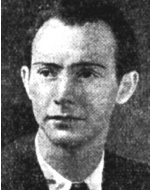Lustig, Abraham (Alexander)
Son of Francesca and Rudolf, was born in 1924 in Hungary to an educated and assimilated family. While he was still in high school, he had a special talent for painting, and then continued to develop his talent at the Art Academy in Budapest. In the Second World War he joined the Hungarian fighters against fascism and in battles, in forests and in the underground, during the war. When he returned home at the end of the war, he found only his little brother who was hiding with a Christian family. Alexander-Avraham took his brother with him and immigrated to Israel in 1946. Here he joined Kibbutz Dorot, and even though he loved the place and the work of the land, the desire and desire to study and develop in art grew in him. After six months of his stay in Dorot he moved to Jerusalem and worked as a painter and graphic artist To Israel and at the same time studied at Bezalel. With the outbreak of the War of Independence after the United Nations General Assembly decided on 29 November 1947 to divide the country into two states, we did not hear the JNF’s demand that it be released from service, From which he did not return a note in his diary: “To suffer – there is nothing, to die – there is nothing, if we know for what and why” – he took part in many battles for the defense of Hebrew Jerusalem, Palmach and Hachash fighters who were sent as reinforcements to Gush Etzion after the large attack on the Gush on 14.1.1948. The fighters departed from Hartuv on the night of January 15-16 and were loaded with weapons, ammunition and equipment, but due to the late hour of departure and the difficulties of the road, they could not reach Gush Katif in the night. At dawn, the department was discovered by villagers in the area of the villages of Beit Natif, Jaba and Surif, who called the Arabs of the area to the area and surrounded the department. The fighters organized themselves on one of the hills (the “Battle Hill” today) and fought with the masses of Arabs until they all fell in battle on January 16, 1948. He was buried in Kfar Etzion and left behind many works of art, (November 17, 1949) was transferred, with all the fallen of the Gush, to eternal rest in the military cemetery on Mount Herzl in Jerusalem
